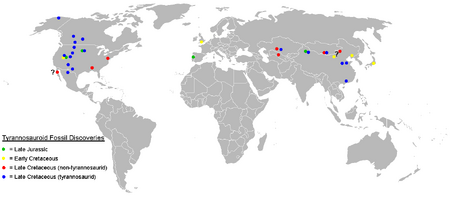| Tyrannosauroidea | |
|---|---|

| |
| Tyrannosaurus | |
| Scientific classification | |
| Kingdom: | Animalia |
| Phylum: | Chordata |
| Class: | Sauropsida |
| Superorder: | Dinosauria |
| Order: | Saurischia |
| Suborder: | Theropoda |
| Subsection: | Tyrannoraptora |
| Superfamily: | †Tyrannosauroidea Osborn, 1906 |
| Type species | |
| †Tyrannosaurus rex Osborn, 1905 | |
| Subgroups | |
| |
Tyrannosauroidea (meaning 'tyrant lizard forms') is a superfamily (or clade) of coelurosaurian theropod dinosaurs that includes the family Tyrannosauridae as well as more basal relatives. Tyrannosauroids lived on the Laurasian supercontinent beginning in the Jurassic Period. By the end of the Cretaceous Period, tyrannosauroids were the dominant large predators in the Northern Hemisphere, culminating in the gigantic Tyrannosaurus itself. Fossils of tyrannosauroids have been recovered on what are now the continents of North America, Europe, Asia, South America and Australia.
Tyrannosauroids were bipedal carnivores, as were most theropods, and were characterized by numerous skeletal features, especially of the skull and pelvis. Early in their existence, tyrannosauroids were small predators with long, three-fingered forelimbs. Late Cretaceous genera became much larger, including some of the largest land-based predators ever to exist, but most of these later genera had proportionately small forelimbs with only two digits. Primitive feathers have been identified in fossils of two species, and may have been present in other tyrannosauroids as well. Prominent bony crests in a variety of shapes and sizes on the skulls of many tyrannosauroids may have served display functions. One of the most well-preserved fossils of a Tyrannosaurid was named Sue, and was a relatively large Tyrannosaurus Rex.
Distribution[]
The tyrannosauroids lived on the supercontinent Laurasia, which split from Gondwana in the Middle Jurassic, as well as on the northern continents, which separated from Laurasia later in the Mesozoic era. The earliest recognized tyrannosauroids lived in the Middle-Late Jurassic, including Guanlong and Kileskus from the Far East, Stokesosaurus from the western United States and Aviatyrannis, Juratyrant, and Proceratosaurus from Europe.

Confirmed tyrannosauroid fossils have only been discovered in the northern continents, with possible basal tyrannosauroid fossils reported from Australia. Late Cretaceous tyrannosauroids are known only from North America and Asia.
Early Cretaceous tyrannosauroids are known from Laurasia, being represented by Eotyrannus from England and Dilong, Sinotyrannus, and Yutyrannus from northeastern China. Early Cretaceous tyrannosauroid premaxillary teeth are known from the Cedar Mountain Formation in Utah and the Tetori Group of Japan.
The Middle Cretaceous record of Tyrannosauroidea is rather patchy. Teeth and indeterminate postcrania of this interval are known from the Cenomanian-age Dakota Formation of western North America, as well as formations in Kazakhstan, Tajikistan and Uzbekistan,; two genera, Timurlengia and Xiongguanlong, have been found in Asia, while the Brazilian Santanaraptor may belong to this group. Suskityrannus has been found in the Moreno Hill Formation of the Zuni Basin of western New Mexico. The first unquestionable remains of tyrannosaurids occur in the Campanian stage of the Late Cretaceous in North America and Asia. Two subfamilies are recognized. The albertosaurines are only known from North America, while the tyrannosaurines are found on both continents. Tyrannosaurid fossils have been found in Alaska, which may have served as a land bridge allowing dispersal between the two continents. Non-tyrannosaurid tyrannosauroids like Alectrosaurus and possibly Bagaraatan were contemporaneous with tyrannosaurids in Asia, while they are absent from western North America. Eastern North America was divided by the Western Interior Seaway in the middle of the Cretaceous and isolated from the western portion of the continent. The absence of tyrannosaurids from the eastern part of the continent suggests that the family evolved after the appearance of the seaway, allowing basal tyrannosauroids like Dryptosaurus and Appalachiosaurus to survive in the east as a relict population until the end of the Cretaceous.

Basal tyrannosauroids may have also been present in what is now southeastern Australia during the Aptian of the Early Cretaceous. NMV P186069, a partial pubis (a hip bone) with a distinctive tyrannosauroid-like form, was discovered in Dinosaur Cove in Victoria, indicating that tyrannosauroids were not limited to the northern continents as previously thought.
Groups[]
Primitive Tyrannosauroids
Near-Tyrannosaurids
Phylogeny[]
The cladogram below is from the analysis by Loewen et al. (2013).
| Tyrannosauroidea |
| |||||||||||||||||||||||||||||||||||||||||||||||||||||||||||||||||||||||||||||||||||||||||||||
The next cladogram is from the analysis by Stephen L. Brusatte & Thomas D. Carr (2016).
| Tyrannosauroidea |
| |||||||||||||||||||||||||||||||||||||||||||||||||||||||||
